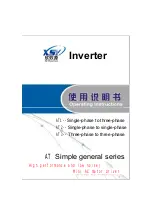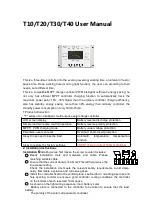
Page 11
Grounding to earth or to other designated ground
For safety, the metal chassis of the inverter is required to be grounded to the earth ground or
to the other designated ground (For example, in a mobile RV, the metal frame of the RV is
normally designated as the negative DC ground). An equipment grounding bolt with a wing
nut has been provided for grounding the metal chassis of the inverter to the appropriate
ground.
When using the inverter in a building, connect a # 8 AWG insulated stranded copper wire
from the above equipment grounding bolt to the earth ground connection ( a connection that
connects to the ground rod or to the water pipe or to another connection that is solidly
bonded to the earth ground ). The connections must be tight against bare metal. Use star
washers to penetrate paint and corrosion.
When using the inverter in a mobile RV, connect a # 8 AWG insulated stranded copper wire
from the above equipment grounding bolt to the appropriate ground bus of the RV (usually
the vehicle chassis or a dedicated DC ground bus ). The connections must be tight against
bare metal. Use star washers to penetrate paint and corrosion.
The inverter contains internal switching devices which generate conducted and radiated
electromagnetic interference (EMI).
The magnitude of EMI is limited to acceptable levels by circuit design but can not be
entirely eliminated. The effects of EMI will also depend upon a number of factors
external to the power supply like proximity of the inverter to the EMI receptors, types
and quality of connecting wires and cables etc. EMI due to factors external to the inverter
can be reduced as follows:
- Ensure that the inverter is firmly grounded to the ground system of the building or the
vehicle
- Locate the inverter as far away from the EMI receptors like radio, audio and video
devices as possible
- Keep the DC side cables between the battery and the inverter as short as possible.
- Twist the DC side cables. This will partially cancel out the radiated noise from the
cables
- Shield the DC side cables with metal sheathing / copper foil / braiding
- Use co-axial shielded cable for all antenna inputs (instead of 300 ohm twin leads)
- Use high quality shielded cables to attach audio and video devices to one another
- Do not operate other high power loads when operating audio / video equipment
LIMITING ELECTRO-MAGNETIC INTERFERENCE
(EMI)













































